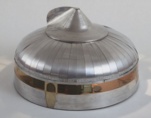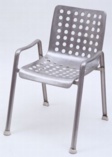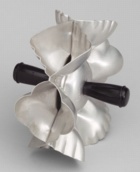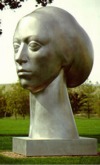
Atomic symbol Al; atomic number 13; atomic weight 26.98; specific gravity 2.69; valence 3.
This metal, known as aluminum in the United States, is known as aluminium in most other countries.
Examples of works using aluminum:

R. Buckminster Fuller (American, 1895-1983), Dymaxion Dwelling Machine, Wichita, Kansas, 1944-46, model in aluminum and plastic, height 20 inches (50.8 cm), diameter 36 inches (91.4 cm), Museum of Modern Art, NY. See architect, architecture, and dome.
Alexander Calder (American, 1898-1976), Spiny, 1942, sheet aluminum, painted stabile, 26 x 30 x 14 3/8 inches (66 x 76.1 x 36.5 cm), Museum of Modern Art, NY.

Hans Coray (Swiss, 1906-1991), Landi Chair, 1938, bent and pressed aluminum, and rubber, 30 1/2 x 21 1/4 x 22 1/8 inches (77.5 x 54 x 56.2 cm), manufactured by P. & W. Blattmann Metallwaren-Fabrik, Switzerland. See design, furniture, and Swiss art.

Jackson Pollock (American, 1912-1956), Number 7, 1950, 1950, oil, enamel, and aluminum paint on canvas, 23 inches x 9 feet 1 3/8 inches (58.5 x 277.8 cm), Museum of Modern Art, NY. See Abstract Expressionism.

Unknown Designer (nationality unknown), Cookie Cutting Wheel, 1953, aluminum and plastic, 4 x 5 inches (10.2 x 12.7 cm), manufactured by Foley Mfg. Co., Minneapolis, MN. See design.
![]() Claes Oldenburg (American, 1929-) and Coosje
van Bruggen (Dutch-American, 1942-), Torn Notebook, 1992,
fabricated 1996, painted aluminum, stainless steel armature,
notebook: 21 feet 10 inches x 23 feet x 26 feet 1 inches, north
page: 10 feet x 14 feet 1 inch x 7 feet 1 inch, south page: 11
feet 8 inches x 8 feet 7 inches x 8 feet 2 inches, Sheldon Memorial
Art Gallery and Sculpture Garden, U of Nebraska, Lincoln.
Claes Oldenburg (American, 1929-) and Coosje
van Bruggen (Dutch-American, 1942-), Torn Notebook, 1992,
fabricated 1996, painted aluminum, stainless steel armature,
notebook: 21 feet 10 inches x 23 feet x 26 feet 1 inches, north
page: 10 feet x 14 feet 1 inch x 7 feet 1 inch, south page: 11
feet 8 inches x 8 feet 7 inches x 8 feet 2 inches, Sheldon Memorial
Art Gallery and Sculpture Garden, U of Nebraska, Lincoln.

Philip Grausman (American, contemporary),
Leucantha, 1993, cast
aluminum, 1 / 3, 108 x 118 x 118 inches, Grounds For Sculpture,
NJ.
https://inform.quest/_art
Copyright © 1996-![]()